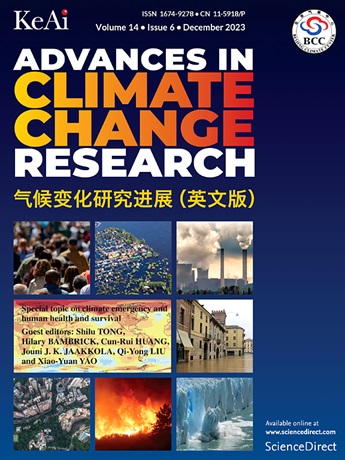Quantifying the impact of infrastructure-based urban adaptation strategies on summer air temperature and heat exposure risk in Chinese cities
IF 5.2
1区 地球科学
Q1 ENVIRONMENTAL SCIENCES
引用次数: 0
Abstract
Infrastructure-based heat reduction strategies, such as using cool building materials (high albedo) and street greenery, can be effective methods for cooling cities. However, the effectiveness of different measures on near-surface air temperature and population heat exposure in cities remains unclear. This study used the Weather Research and Forecasting model coupled with the single-layer urban canopy model and conducted one control and four urban adaptation strategy simulations (cool roof, green roof, urban tree and full adaptation) with a convection-permitting scale of 3 km in eastern China during the warm season of 2022. Our findings reveal that these strategies notably decreased 2 m air temperature, with averaged cooling effects of daily air temperature in 37 cities reaching −0.4 °C (cool roof), −0.3 °C (green roof), −0.2 °C (urban tree) and −0.6 °C (full adaptation). The cooling effects in cities illustrated notable regional characteristics; that is, they were stronger in Central China, East China, South China and North China but weaker in Southwest, Northwest and Northeast. Based on the results of multiple linear regression, we attributed the dominant climate factor of each measure: Bowen ratio for cool roof and urban tree and full adaptation and downward shortwave flux for green roof. In addition, urban adaptation strategies greatly reduced extreme heat hours in 37 cities, with averages of 67 (cool roof), 47 (green roof), 22 (urban tree) and 88 h (full adaptation). Furthermore, urban adaptation strategies substantially reduced population heat exposure in populated cities, such as Shanghai (2.48 billion person-h), Guangzhou (1.48 billion person-h), Beijing (1.26 billion person-h) and Shenzhen (1.17 billion person-h). In summary, urban cooling measures can notably decrease air temperature and reduce heat exposure risk during the warm season in cities but vary in their effectiveness in various cities, which highlights the need for region-specific approaches for adaptation to climate change.
基于基础设施的城市适应策略对中国城市夏季气温和热暴露风险的量化影响
基于基础设施的减热策略,如使用凉爽的建筑材料(高反照率)和街道绿化,可以成为冷却城市的有效方法。然而,不同措施对城市近地表气温和人口热暴露的有效性尚不清楚。本研究利用天气研究与预报模型与单层城市冠层模型耦合,在2022年暖季中国东部地区进行了1个对照和4个城市适应策略(冷屋顶、绿屋顶、城市树和完全适应)模拟,模拟尺度为3 km,允许对流。我们的研究结果表明,这些策略显著降低了2米的气温,37个城市的平均日气温降温效果达到- 0.4°C(冷屋顶)、- 0.3°C(绿色屋顶)、- 0.2°C(城市树木)和- 0.6°C(完全适应)。城市降温效应呈现显著的区域特征;即华中、华东、华南和华北偏强,西南、西北和东北偏弱。基于多元线性回归的结果,我们将各措施的主导气候因子归为:冷屋顶和城市树木的Bowen比和绿色屋顶的完全适应和向下短波通量。此外,城市适应策略显著减少了37个城市的极端热小时,平均为67 h(冷屋顶)、47 h(绿色屋顶)、22 h(城市树)和88 h(完全适应)。此外,城市适应策略显著降低了人口密集城市的人口热暴露,如上海(24.8亿人h)、广州(14.8亿人h)、北京(12.6亿人h)和深圳(11.7亿人h)。总之,城市降温措施可以显著降低城市温暖季节的气温和热暴露风险,但其有效性在不同城市有所不同,这突出了适应气候变化的区域具体方法的必要性。
本文章由计算机程序翻译,如有差异,请以英文原文为准。
求助全文
约1分钟内获得全文
求助全文
来源期刊

Advances in Climate Change Research
Earth and Planetary Sciences-Atmospheric Science
CiteScore
9.80
自引率
4.10%
发文量
424
审稿时长
107 days
期刊介绍:
Advances in Climate Change Research publishes scientific research and analyses on climate change and the interactions of climate change with society. This journal encompasses basic science and economic, social, and policy research, including studies on mitigation and adaptation to climate change.
Advances in Climate Change Research attempts to promote research in climate change and provide an impetus for the application of research achievements in numerous aspects, such as socioeconomic sustainable development, responses to the adaptation and mitigation of climate change, diplomatic negotiations of climate and environment policies, and the protection and exploitation of natural resources.
 求助内容:
求助内容: 应助结果提醒方式:
应助结果提醒方式:


